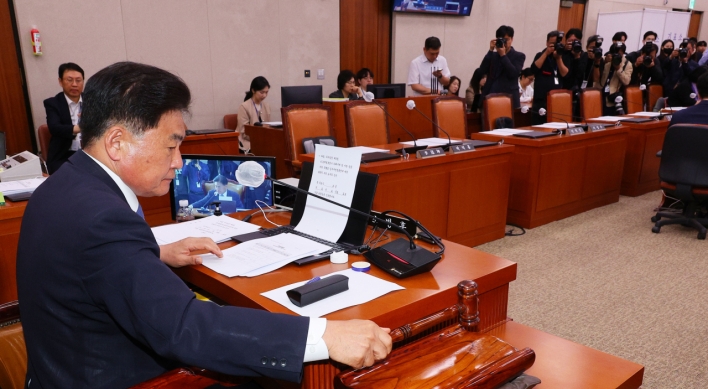[Lee Kyong-hee] Tears of a young pilgrim shed on Afghan soil
By Korea HeraldPublished : Sept. 16, 2021 - 05:30

The cascading events that followed the US exit from Afghanistan reminded me of a poem written by a young Buddhist monk of the eighth century. Hyecho, from the Silla Kingdom, upon meeting a fellow traveler from China in Fayzabad, in present-day northeast Afghanistan, wrote:
You bemoan the distance to the western frontier.
I lament the long road east.
Rugged roads cross colossal snow ridges,
Dangerous ravines where bandits wander.
Even birds in flight fear the soaring cliffs.
Travelers struggle over tilting bridges.
I have never cried once in my life.
Today I shed a torrent of tears.
Hyecho was headed home, after his trek across India in 723 to 727. His diary that contained the poem doesn’t explain his tears. Perhaps he finally felt overwhelmed by the emotional toll of traveling alone, so removed from home, knowing he still had to cross the lofty Pamir Mountains before reaching “safe territory.”
The diary, “Memoir of the Pilgrimage to the Five Regions of India” (Wang ocheonchukguk jeon), reveals that Hyecho visited five places of present-day Afghanistan.
One was Bamiyan. He wrote: “The king is of a barbarian tribe, and the country is not subject to any other nation. The military is strong and large, and none of the surrounding countries dare attack them. … The weather here is very snowy and cold. Most people live in the mountains. The king, chiefs and commoners all greatly revere the Three Jewels [the Buddha, the Dharma and the Sangha]. There are many monasteries and monks and both Mahayana and Hinayana are practiced. The men cut their hair and shave their beards as they do in Zabulistan [today’s southern Afghanistan] and elsewhere. Their language is different from that of other places.”
Curiously, there is no mention of the Buddhas of Bamiyan, the largest examples of standing Buddha carvings in the world before they were destroyed by Taliban vandals in March 2001. The imposing images, dated to the late sixth to early seventh centuries, were the most famous cultural landmarks of the region. The destruction of these images was an ominous prelude to the al-Qaida’s terrorist attacks on New York City and Washington, DC, six months later.
Famous Chinese monk Xuanzang, who traveled to Bamiyan in 643, left a detailed description of the images in “The Great Tang Records of the Western Regions” (Da Tang xiyu ji).
“To the northeast of the city, there is at a corner of the mountains a rock statue of the Buddha standing, 140 or 150 feet in height, a dazzling golden color and adorned with brilliant gems. To the east there is a monastery built by a previous king of the country. To the east of the monastery there is a copper statue of the Buddha standing, more than 100 feet tall. It was cast in separate pieces and then welded together into shape.”
Here the rock-cut sculptures are described as being embellished with metal, color pigments and precious stones. Probably this made them appear as if having been cast of copper. Xuanzang further noted that “merchants coming and going happen to witness visions of heavenly deities, whether as good omens or as predictions of disaster; they worshiped the deities to pray for blessedness.”
Bamiyan is often included in the greater cultural sphere of Gandhara, with their Buddhist communities and artistic traditions connected. Gandhara, based in the Peshawar Valley in present-day northwest Pakistan, prospered at the crossroads of Asia, linking trade routes and embracing cultural influences from diverse civilizations. From here, Mahayana Buddhism spread to Central Asia and then to China, Korea and Japan, along the Silk Road.
The Gandhara style of Buddhist art, displaying Greco-Bactrian, Roman and Indian as well as Parthian and Scythian influences, flourished during the Kushan Empire from the first to the fifth centuries. During this period, the first image of the Historical Buddha was crafted in human form incorporating Hellenistic elements, ending the aniconism of early Buddhism.
Hyecho went north from Bamiyan, and after 20 days, reached Balkh, a hub of the Greco-Buddhist civilization of Bactria, its origins dating to the Indian campaign of Alexander the Great in the fourth century BC. Then the intrepid monk went eastward to Fayzabad, the commercial and administrative center of the Tamir region.
From Fayzabad, for reasons unknown, Hyecho went further west to Persia (modern Iran) and then Arabia, instead of heading homeward to the east. He probably attached himself to a merchant caravan, but we don’t know why.
“From Tokhara [Balkh] I traveled west for one month and arrived in Persia. A long time ago, the king of this country ruled over the Arabs. … However, a revolution erupted, the king of Persia was killed and an Arab became king. It is said that the people’s character is suited for commerce, and they are continuously sailing from the east sea to the south sea, as far as Simhala [Sri Lanka] where they obtain all sorts of treasures. … They also obtain gold from Kunlunguo [Mekong Delta], sail to Chinese lands and on to Guangzhou where they buy plain and patterned silk fabrics, silk thread and cotton.” (English translations from the University of Michigan website on Hyecho’s journey)
Hyecho’s destination was presumably Nishapur. From there he went to enter the mountainous country of Dashi (Arabia) before crisscrossing the rugged mountains and deserts via Samarkand and Tashkent, finally crossing over the Pamir Mountains. Past the narrow strip of Afghan territory bordering China, which is called the Wakhan Corridor today, he arrived at Tashkurgan, then a western military outpost of the Tang and today a section of the Sino-Afghan border of the Xinjiang Uyghur Autonomous Region.
With the US withdrawal from its failed 20-year nation-building endeavor in Afghanistan, international attention is shifting to US-China relations and Beijing’s policy toward the Taliban regime in Kabul. Leaders of nations should rack their brains collectively to find ways to end the country’s long tragedy of blood and tears.
Lee Kyong-hee
Lee Kyong-hee is a former editor-in-chief of The Korea Herald. She is currently editor-in-chief of Koreana, a quarterly magazine of Korean culture and arts published by the Korea Foundation. -- Ed.
-
Articles by Korea Herald









![[Kim Seong-kon] Democracy and the future of South Korea](http://res.heraldm.com/phpwas/restmb_idxmake.php?idx=644&simg=/content/image/2024/04/16/20240416050802_0.jpg&u=)









![[Today’s K-pop] Zico drops snippet of collaboration with Jennie](http://res.heraldm.com/phpwas/restmb_idxmake.php?idx=642&simg=/content/image/2024/04/18/20240418050702_0.jpg&u=)